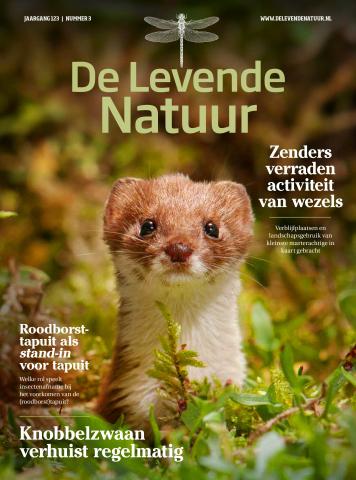De Levende Natuur nummer 3 van 2022 (English summary)
Afbeelding

Bodyweight and diet of stonechats on acidic heathlands and calcareous coastal dunes
Atmospheric deposition of acids has been leading to depletion of minerals from acidic, Pleistocene soils in The Netherlands since the 1970s. Therefore, nutrient composition of plants changed, affecting populations of herbivorous insects, which, in turn, may affect populations of insectivorous birds. Insect communities in calcareous coastal grasslands are less affected by acidification due to buffering capacity of the soil. To investigate whether declining insect populations affect insectivores, I here compare bodyweights and nestling diets of the stonechat, an insectivorous songbird, on acidic heathlands (Veluwe) and a calcareous dune area (Vogelduin) during 2020- 2021. Nestlings appeared to have lower weights, received fewer caterpillars and, in some nests, small prey (ants, small diptera) in Veluwe. Hence, stonechats may well face nutritional constraints in Veluwe. Heavier songbirds, such as the Northern wheatear, may not be able to find enough food on heathlands to fledge their young, contributing to its extinction in Veluwe.
Mute Swans in and outside the city, seperate worlds?
In this article we present data of swans ringed als juveniles in the urban environment of Almere in the period 2004-2021. Contrary to common believe, urban raised swans do not stick to this environment and to their raising grounds. Ringed birds were encountered up to 140 km from their raising grounds, on average 13,5 km for females and 15,5 km for males. Habitats include agricultural and grazing fields where the birds can damage crops and grasslands. In agricultural areas with high numbers of swans the practice of nest reduction and shooting is allowed. Since this is – for good reasons – not allowed in the urban environment, one can argue the effectiveness of these measures to control the population. The interchange between the urban and agricultural habitat should be considered when proposing management policies. On top of that we plea for a policy where the high appreciation of these birds by the general public is also part of the equation.
Transmitters reveal residence and landscape use of least weasels
Over the past century, the least weasel has strongly declined in the Netherlands. This species is protected in approximately half of all Dutch provinces, which, in addition to the protection of the individual, also involves habitat protection. However, much is still unknown about their habitat use, including roosts. Between early September and November 2020, nine individuals have been equipped with a radio transmitter and were tracked for 2-34 days. In the study area “De Mortelen”, weasels used a network of roosts within their territory and often moved to new roosts, but also returned to old ones. They did not seem critical in roost choice, yet, the degree of coverage proved to be of great importance. It has been observed that weasels seldom move through unsheltered terrain. Conversely, they exclusively made use of woodland edges, extensively grazed meadows, and overgrown ditches. On a landscape level, sufficient cover therefore seems to be of great importance. Because any area with a certain amount of cover can potentially be suitable as a residence or habitat, we expect that, within the framework of the Dutch Nature Conservation Act, mitigation in advance, rather than further research, may be more favourable to weasels.
A field test with eDNA
Small mustelids such as polecat, weasel and stoat have a hidden way of life and are difficult to investigate, even with camera traps. This pilot shows that searching for feces or DNA traces in the environment (eDNA) has potential for monitoring of mustelids. However, further research is necessary to develop this method.

